In today’s subwoofer market, the SVS SB-3000 subwoofer will be a sweet spot for many in terms of performance, features, and value. It’s far from the most-expensive sub on the market – in fact, it’s not the costliest subwoofer in SVS’s lineup – but it delivers much more punch and low-frequency reinforcement than you might expect at this price. The SB-3000 offers a 13-inch driver, plenty of power, and excellent extension, all in a cabinet roughly 16 inches high by 15 inches wide and 18 inches deep. Its outstanding app also aids in integrating the SVS SB-3000 seamlessly and easily into nearly any music playback system. The result is a fine audiophile subwoofer at a surprisingly moderate price.
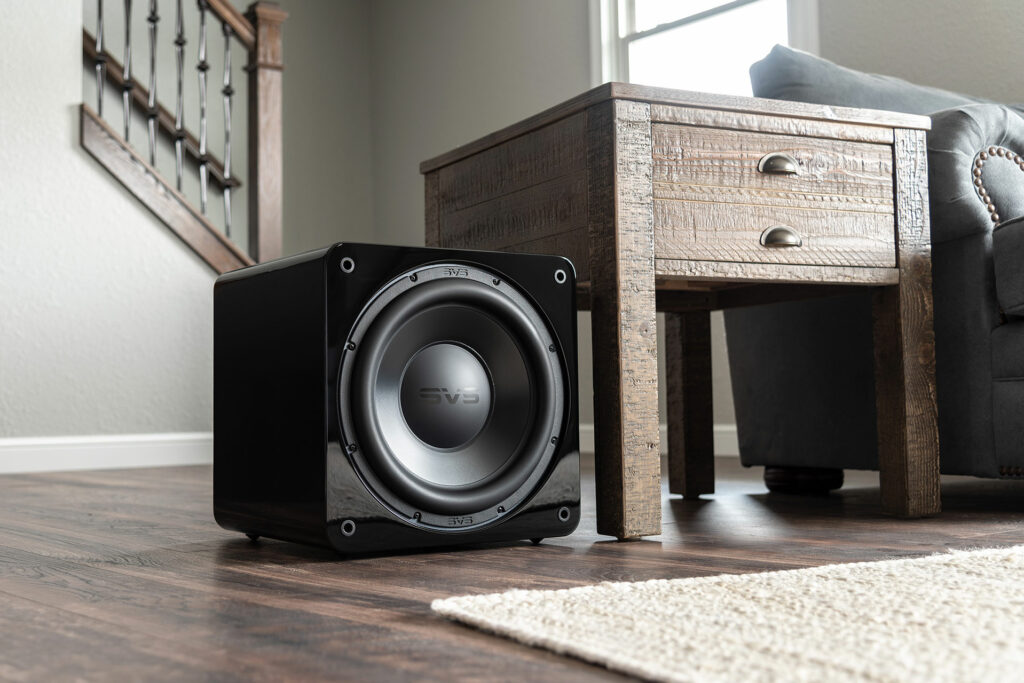
Answering Three Audiophile Questions About Subwoofers
Why should an audiophile add a sub to their two-channel system? Paired with smaller speakers of limited low-frequency range, more bass is the main benefit of adding a sub. If you use a high-pass filter on the main speakers, the subs also will take the bass load off them (and your amplifier) to let the main loudspeakers do what they do best: reproduction of the midrange and high frequencies. Paired with full-range or floorstanding loudspeakers, a subwoofer also can produce more even bass than the main speakers alone. Because of standing waves, a bass melody line played back in a room without subs usually has unequal volume as it moves up and down the scale. Audiophiles get used to this but shouldn’t. The better solution is to add a subwoofer or two. If you place the main speakers for best midrange and high frequency playback, and the sub(s) for best bass, you can get strong, solid, and smooth response that makes bass lines more compelling and fun to follow.
Do I need more than one sub in my audiophile system? One sub will improve most audiophile systems in dramatic ways, especially if the main speakers are a little light in the bottom end. Twosubwoofers can do better at filling icky room-related nulls. Four subs (usually in room corners) can provide even more realistic bass, with amazing smoothness across frequencies and all seating positions. If you have the room and the long-term budget for them, I’m a big fan of using two or more subs, rather than a single larger one. In fact, I’ve used four subs for several years and wouldn’t go back to one or two.
Is installing a subwoofer a DIY project for even a new audiophile? Conceptually, it’s not difficult to set up a subwoofer – especially an SVS – but getting the best results requires attention to placement and adjustment. An external crossover or a preamp with bass management can help, though many audiophiles do it without them. The best subs offer sufficient control to get good results even when placement options are limited.
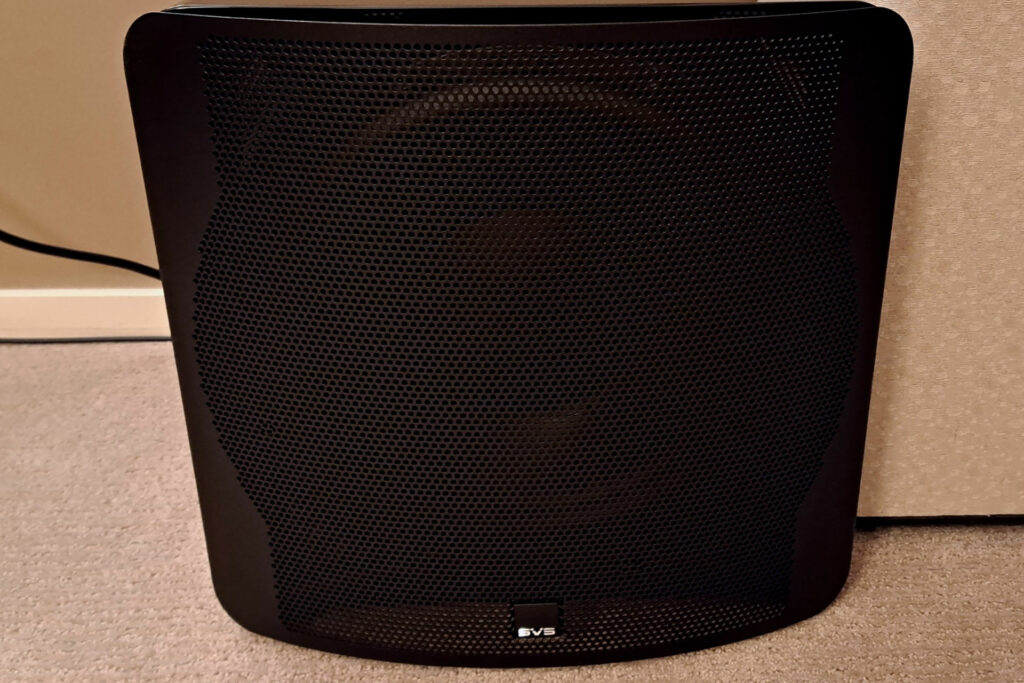
What Makes the SVS SB-3000 Subwoofer Special?
- The SB-3000 goes really low. The specified quasi-anechoic response is 18 to 270Hz, ± 3 dB, and with the unit’s shallow roll-off and expected placement near a wall, SVS claims typical in-room response nearly flat to about 16 Hz. My measurements started at 15 Hz, and in my room, the SVS SB-3000 is flat from 15 Hz up. That’s impressive, especially when you consider that SVS has a bigger model, the SVS SB-4000, with even more output.
- The SB-3000 is powerful, with SVS’s Class-D Sledge amplifier rated at 800 watts of continuous power and 2,500 watts for peaks. That’s a lot of power and subwoofers tend to need such headroom in quick bursts.
- You can set up the SVS SB-3000 subwoofer easily from your listening chair. The robust app (Android or iOS) can set volume, low-pass filter slope and frequency, low-frequency roll off and slope (to avoid room boom), three parametric equalization (PEQ) filters, polarity, and phase in one-degree increments. Three groups of settings can be stored in the sub and recalled. This degree of control dramatically increases the odds that you will get a good setup in your room, making the app a vital feature of the SB-3000 (and other SVS subs).
- The sealed-box construction is well suited to audiophile music systems. Sealed subs are often recommended in music systems for their accuracy and control, though if you listen to pipe organ music daily, don’t rule out a high-quality ported sub. Typically, ported subs are more capable of moving enough air to make the cuffs on your pants sway a little bit. Ported subs also tend to be used more in home theater applications, as sealed designs move less air but have a bit more control. Like serving red wine with fish, these are rules that are meant to be broken.
- The SB-3000 is compact and relatively light for a such a powerful subwoofer, making it physically easier to place in the listening room. The finish and design of the SB-3000 are attractive (mine have the gloss finish) and at 55 pounds, this is one sub you can move around without wrecking your back.
- SVS has legendary customer service. I’ve owned SVS subs for years, and the few times I’ve contacted the company, I’ve been delighted with their quick, courteous, and helpful responses. They have a long in-home demo program too, making it easy to test out their speakers and subs without much risk.
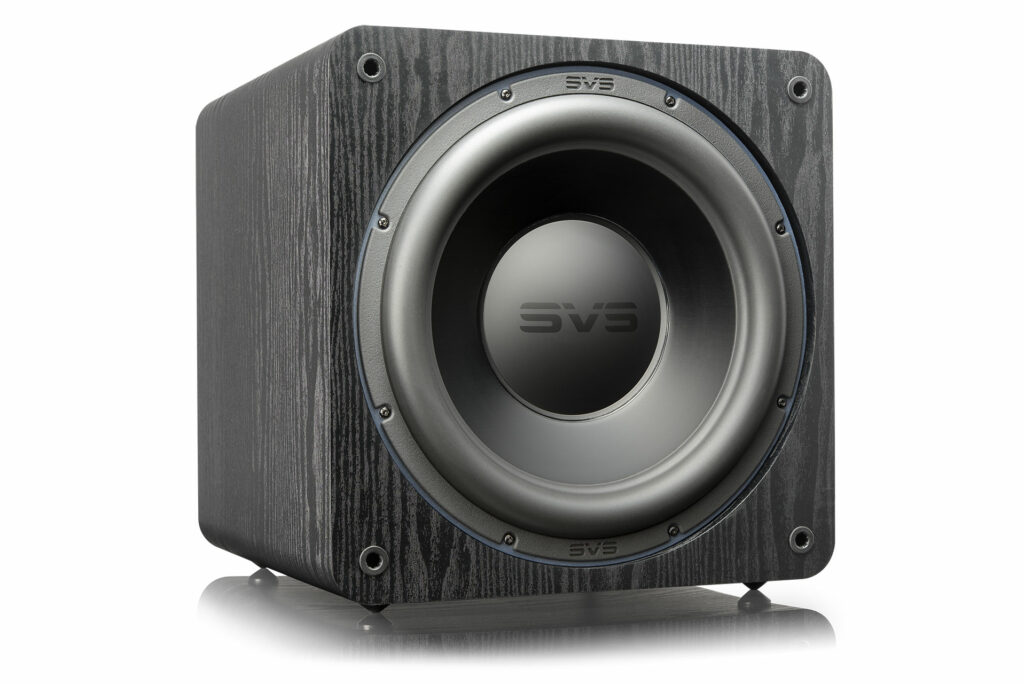
Why Should You Care About the SVS SB-3000 Subwoofer?
SVS is one of the largest and best-regarded subwoofer manufacturers and the SB-3000 falls right in the middle of their product line. It is an overachiever of a subwoofer that, for a very reasonable price, can help take most audio systems to a new level.
To show how good the SVS app is, look at the bass response (graph below) of a pair of SB-3000 subs, measured at my listening chair after adjusting the subs via the app. Most such plots have variation up to ± 30 dB, caused by room peaks and nulls. Here, that’s been improved dramatically by using two subs and making adjustments in the app.
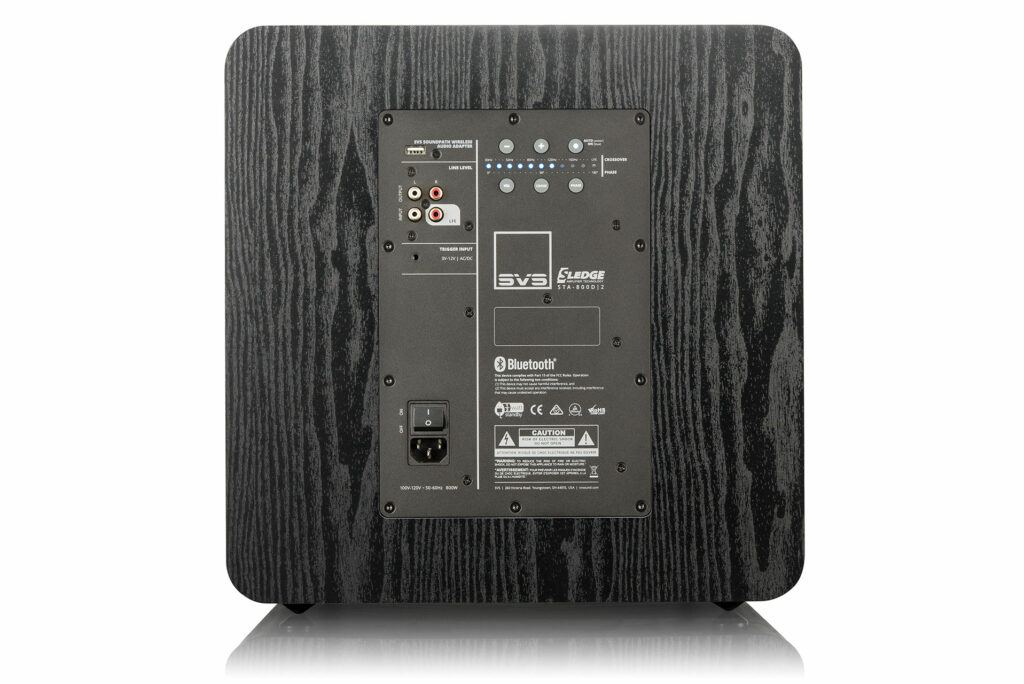
Some Things You Might Not Like About the SVS SB-3000 Subwoofer
- The SVS SB-3000 offers only RCA line-level inputs. Using a balanced interconnect from a preamp will require an inexpensive adapter.
- Optimal setup may involve using measurement tools to get the last drop of performance from a sub like the SVS SB-3000. Finding the best placement, setting the app’s three PEQ filters, and adjusting phase to best integrate with the main speakers are all most effectively done while measuring response from the listening chair. This is true not just of the SVS SB-3000, but of any high-performance subwoofer. Even subs with automated equalization do not, to my knowledge, offer automated level and phase settings, so measuring still is needed. Fortunately, the measurement software REW is free, and a serviceable measurement mic, such as the miniDSP UMIK-1, can be had for as little as $79. An alternative with an easier learning curve is the Dayton OmniMic2 system, though it’s often out of stock.
- The SVS app works as designed but could use a little fine tuning. I’d love a feature to save all settings onto my tablet, so I’d have a backup when I screw things up. And please, a bolder font for the main menu, which on Android at least is so faint it’s almost impossible to read.
Listening To the SVS SB-3000 Subwoofer…
In my basement listening room, with its extensive acoustical treatments, my Janszen Valentina P8main speakers measure down to 20 Hz, but I have a deep room null around 40 Hz at the listening chair. I put one SVS SB-3000 in each of the room’s corners and set up my Anthem STR Preamplifier with two speaker profiles: one with and one without the SB-3000s.
Playing “Georgia on My Mind” from Archie Shepp’s Black Ballads (Qobuz, CD resolution), I loved hearing avant-garde Shepp and crew playing in an accessible, lyrical mode. With the SVS SB-3000s in circuit, Wayne Dockery’s bass was superbly even and easy to follow melodically. Although this was a somewhat subtle change, it was a real step-up in musical enjoyment. The SVS SB-3000 made tuneful, musical bass that added extension and power to the already very good bass from the main speakers. That’s just what I’d hoped for.
Another key track was “Welcome” from Jon Hopkins’s Music for Psychedelic Therapy (FLAC 44.1/16 download). This music can seem like a trip even without psychedelics, and its mind-bending effect was definitely stronger with the SVS SB-3000s engaged. I heard a larger sense of space and the track’s very low bass sweeps started deeper, with more startling authority. Once again, the SVS SB-3000 didn’t change the character of the bass beyond making it more extended, more even, and more authoritative.
Listening to “Have Mercy” on Shamekia Copeland’s Turn the Heat Up (CD rip 1440 AIFF), once again I found the bass more even and solid with the subs in circuit as opposed to fully lacking any subwoofers. I was impressed – and not just on this track – that the SVS SB-3000 blended so well with my main speakers. Listeners told me they couldn’t tell when the subs kicked in, as the deep, strong bass seemed to come from the main speakers. The last thing I want is a sub that calls attention to itself, and the SVS SB-3000 does not.
Does the SVS SB-3000 Subwoofer Have Any Resale Value?
As a rule, bulky or heavy audio components are harder to resell, but fret not with the SVS SB-3000. The good reputation of SVS products and the SB-3000’s reasonable weight and size should make out-of-town resale easier. I found several used ones online, with prices clustered around $700–$800. Given the active used market, the SVS SB-3000 should retain considerable value. SVS is a marketing powerhouse and they are sold in places like Amazon and Best Buy, so they have a built-in pool of people who might want such a high-performance sub. Another benefit is people like me who had added and added and added subwoofers. If you were ever to sell an SVS SB-3000, you will have plenty of people interested.

What Is the Competition for The SVS SB-3000 Subwoofer?
The Definitive Technology Descend DN12 is priced similarly to the SB-3000. The DN12 has a 12-inch driver and two passive radiators, a 500-watt amp (1,500 watts peak), offers phase adjustment only in 45-degree steps, and is a few inches larger in each dimension than the SB-3000. It has no app and no user-adjustable PEQ.
The ELAC Varro Reference RS500-SB recently reviewed by Steven Stone comes at a slightly higher price ($1,299). The ELAC is a sealed sub with 10-inch driver, 500-watt amp, and specified response of 18 to 150 Hz, with no stated deviation limits. It offers line- and speaker-level inputs and an app with auto-equalization, though I couldn’t find any detailed description of that (and I think details are important).
One of audio’s more storied 13-inch subs is the JL Audio Fathom f113v2 ($6,000). At 133 pounds, it’s more than twice as heavy as the SVS SB-3000 and about five times as expensive. With that comes JL Audio’s automated digital EQ system with its 18-band, 1/6-octave equalizer; balanced and unbalanced inputs; an unusually sturdy cabinet; and an amp specified at 3,000 watts short-term.
The REL T/7x ($1,099) is priced very close to the SVS SB-3000 and is available in attractive black or white gloss finishes. It offers an eight-inch active and a 10-inch passive driver, a 200-watt amplifier, and both speaker- and line-level inputs. Adjustments seem limited to low-pass frequency and sub level. The T/7x is specified as -6 dB at 30 Hz, so it has considerably less low-frequency extension than the SVS SB-3000. I have not used a REL sub, but many audiophiles love them. The product line seems to emphasize simplicity, in contrast to the flexibility provided by SVS.
Of course, SVS itself makes many other models. The SVS 3000 Micro is smaller (roughly 13 inches on a side) and less expensive ($899.99) than the SB-3000 and includes the excellent SVS app and adjustments. Though it doesn’t go as deep as the SVS SB-3000, it might be preferred if space is tight. Conversely, the SVS SB-4000 is larger, more expensive ($1,799), and will play deeper. In a very large room, the SVS SB-4000 probably will outperform the SB-3000. Still, if I had the space, I’d prefer two SB-3000 to one SB-4000 and I am pretty sure Jerry agrees. He simply doesn’t have the ability to have a multi-sub install in his media room.
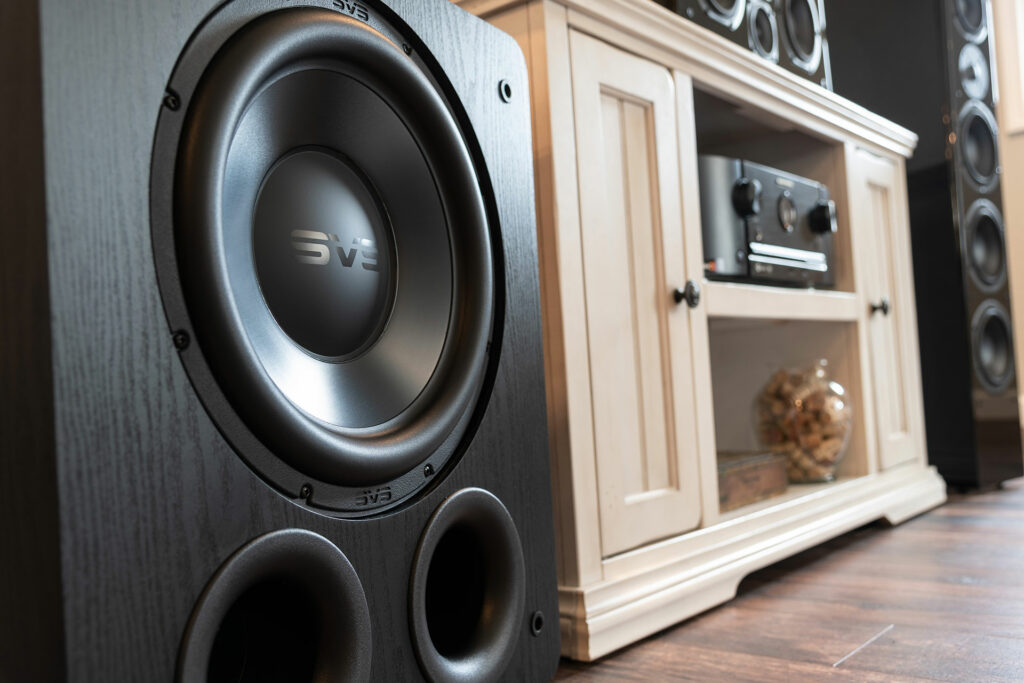
Final Thoughts on the SVS SB-3000 Subwoofer
Some audiophiles claim that subs muddy the sound or blunt the music’s pace and timing. They are just plain nuts. On dozens of tracks, I switched the SVS SB-3000s in and out and found no evidence of these unfounded audiophile clichés. Subwoofer blend and pace were as close to perfect as I’ve heard. I believe that my results reflect careful setup and the high quality of the SVS SB-3000.
Well-integrated subs fill parts of the frequency range – say 20 to 150 Hz – that in many systems have gaps/dips due to room acoustics. (Even with an 80 Hz crossover, a sub contributes something at 150 Hz.) To some listeners, a lack of upper-bass can sound like added clarity. As for me, I’d rather hear the pianist’s left hand along with the right, and without the kind of exaggerated clarity that reminds me I’m listening through electronics.
I used a stereo pair of JL Audio Fathom f112 (v1) subwoofers in my system for 14 years. A year or so ago, I bumped up to four low-frequency transducers by adding a pair of SVS SB-3000 subs, which I chose for great specs and cost effectiveness. It was difficult to dial in four subs from two manufacturers, but eventually I got very good results. For this review, I replaced the JL Audio subs with two more SVS SB-3000s, giving four identical subs. The SVS SB-3000 subs are priced lower, weigh less, have more usable controls, and sound just as good in my system as the JL Audio f112v1 subs did.
Indeed, I think I was able to do a little better in integration because of the SB-3000’s adjustable PEQ. Instead of features you may never use or a cabinet that could support a car, SVS keeps the cost down by giving you what you absolutely do need: controls to help you integrate the sub better with your system. It’s a winning approach, and after all those years, I am parting with my pair of JL Audio f112v1 subs in favor of the two SVS SB-3000 units received for review. You don’t need to know much more than that.




Great review. What was the frequency response of your mains? Where did you cross over the SVS3000?
I forwarded your comments to Mike when I approved them.
Stay tuned – he will very likely respond to you! 🙂
Thanks, Joe. The main speakers are down only about 5 dB at 20 Hz, but with a deep room null around 42 Hz and a milder one around 120 Hz (all measurements at the listening position). I set the crossover at 75 Hz, which ensures the 42 Hz null is filled and helps fill 120 Hz as well. Positioning the subs so they aren’t subject to the same 42 Hz null took some experimentation.
Where can I make a purchase?
You can buy it directly from SVS on their site. Super easy to do.
There are also links to Amazon on the page that give us a little commission. It also helps us show our client that people actually buy their product which is always good.
https://www.svsound.com/pages/international-dealers
Here’s one more resource JUST IN CASE (I am guessing from your name which might be Asian/Vietnamse I am guessing) you are out of the country….
I have no idea but just in case – you are all good.